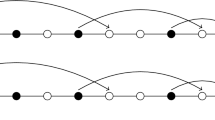Abstract
A brief historical introduction is given to the problem of covering a line by random overlapping intervals. The problem for equal intervals was first solved by Whitworth in the 1890s. A brief resume is given of his solution. The advantages of the present author's approach, which uses a Poisson process, are outlined, and a solution is derived by Laplace transforms. The method of Hammersley for dealing with a stochastic distribution of intervals is described, and a solution can still be derived by Laplace transforms. The asymptotic behavior as the line becomes long is calculated and is related to the one-dimensional continuum percolation problem. It is shown that as long as the mean interval size is finite, the probability of complete coverage decays exponentially, so that the critical percolation probabilityp c =1. However, as soon as the mean interval size becomes infinite, the critical percolation probabilityp c switches to 0. This is in accord with previous results for a lattice model by Chinese workers, but differs from those of Schulman. A possible reason for the discrepancy is a difference in boundary conditions.
Similar content being viewed by others
References
W. L. Stevens,Ann. Eugen. 9:315 (1939).
R. A. Fisher,Proc. R. Soc. A 125:54 (1929).
R. A. Fisher,Ann. Eugen. 10:14 (1940).
W. A. Whitworth,D.C.C. Exercises, including hints for the solution of all the questions in Choice and Chance (Cambridge, 1897) (Reprinted Hafner, 1965).
C. Domb,Proc. Camb. Phil. Soc. 43:329 (1947).
C. Domb,Proc. Camb. Phil. Soc. 44:335 (1947).
J. M. Hammersley,Proc. Camb. Phil. Soc. 49:623 (1953).
W. L. Smith,Proc. Camb. Phil. Soc. 53:175 (1957).
L. Flatto and A. G. Konheim,SIAM Rev. 4:211 (1962).
A. Dvoretsky,Proc. Natl. Acad. Sci. USA 42:199 (1956).
L. A. Shepp,Israel J. Math. 11:328 (1972).
S. R. Broadbent and J. M. Hammersley,Proc. Camb. Phil. Soc. 53:629 (1957).
D. Shalitin,J. Phys. A 14:1983 (1981).
Z. Q. Zhang, F. C. Pu, and B. Z. Li,J. Phys. A 16:L85 (1983).
L. S. Schulman,J. Phys. A 16:L639 (1983).
C. M. Newman and L. S. Schulman,Commun. Math. Phys. 104:547 (1986).
M. Aizenman and C. M. Newman,Commun. Math. Phys. 107:611 (1986).
Dictionary of National Biography (1901–1911), p. 655.
D. Ruelle,Commun. Math. Phys. 9:267 (1968).
D. J. Thouless,Phys. Rev. 187:732 (1969).
J. Frohlich and T. Spencer,Commun. Math. Phys. 84:87 (1982).
P. Hall,Ann. Prob. 13:1250 (1985).
Author information
Authors and Affiliations
Additional information
On sabbatical leave from Physics Department, Bar Ilan University, Ramat Gan, Israel.
Rights and permissions
About this article
Cite this article
Domb, C. Covering by random intervals and one-dimensional continuum percolation. J Stat Phys 55, 441–460 (1989). https://doi.org/10.1007/BF01042611
Received:
Revised:
Issue Date:
DOI: https://doi.org/10.1007/BF01042611



